China Cycling Travelogues
Do you have a China cycling travelogue you would like
to share here?
Contact us for details.

"Cycling to Danba in Western Sichuan, China"
Part 4
Copyright © Peter Snow Cao, 2001.
Cycling Trip to Danba, Sichuan: Part 4 Rilong to Xiaojin
At night, it rains hard, again. Breakfast is at a small shop with large flat round bread, about 12 inches in diameter, and two inches thick. I suddenly get a craving for a fried egg sandwich, and we coax the reluctant cooks to make three giant ones. I like it so much I order a second. Breakfast in China never tasted so good.

The hotel staff warns us that a big landslide just occurred down the road five kilometers, and we better stay another night. We tell them we are going to check it out for ourselves and say farewell to a small crowd of well-wishers.
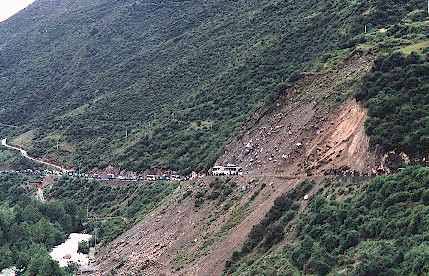
The rain has stopped, though the road is still wet. Trucks are lining up in town waiting for the road to reopen and several people try to warn us we can’t get through. The landslide is visible from a distance marked by a line of trucks and buses on either side. Two buses are trapped between two rock slides on either side on them and the hapless passengers sit like cattle awaiting slaughter. We are able to carry our bikes over the slide areas and the passengers stare out in disbelief.
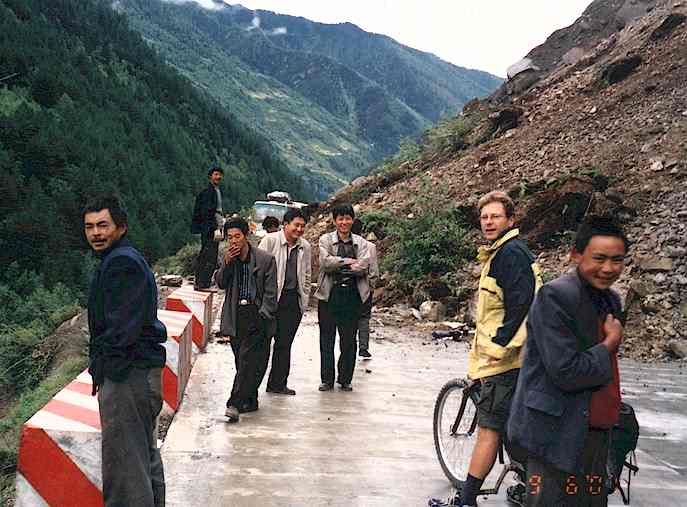
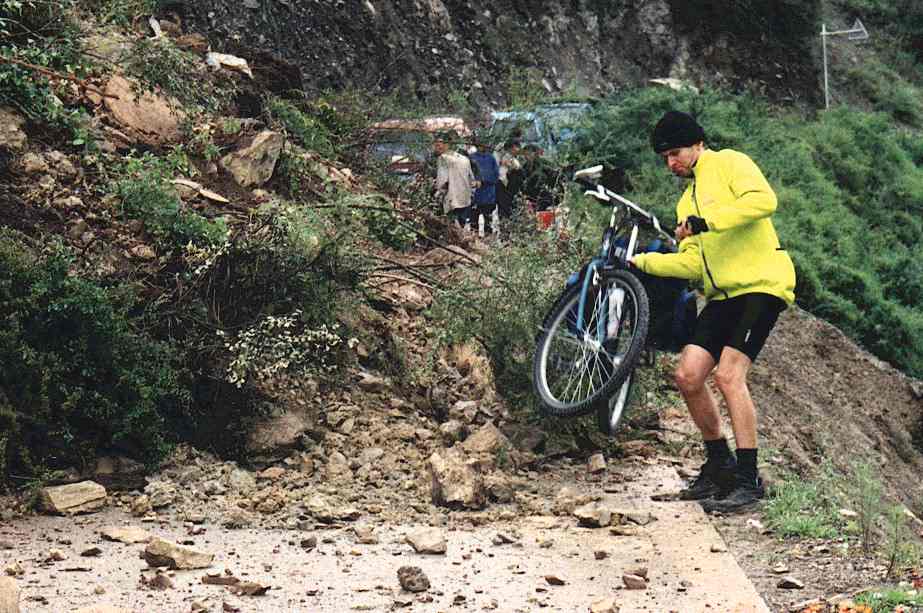
We cycle effortlessly downhill. It is such a stark contrast from yesterday’s climb and we are thoroughly enjoying it. At a particularly beautiful side valley called Shuangqiaogou (Twin Bridge Valley), there is considerable road construction. We decide to check it out and head up half on concrete half on mud. There are a number of minor landslides along the road and nearly all the workmen are wearing hard hats, an unusual occurrence in China. A few of the landslides are active, and we gingerly make our way past them.
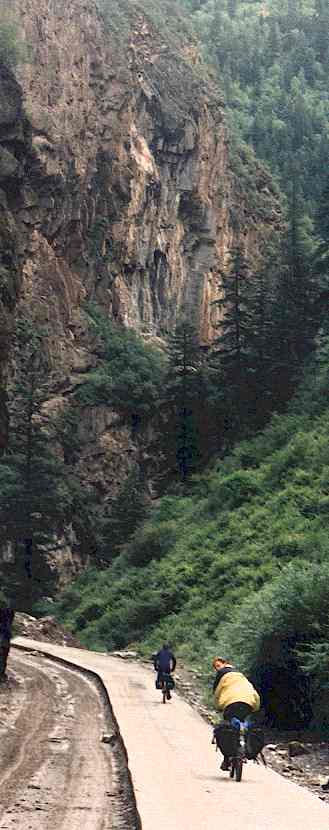
The valley starts out with steep and narrow brown/red rock side with a fast flowing stream raging between. We learn from the workman that view ahead on a clear day is spectacular, but we only catch a glimpse of the snowy peaks. While the rain has stopped, the low-lying clouds hide the best views.
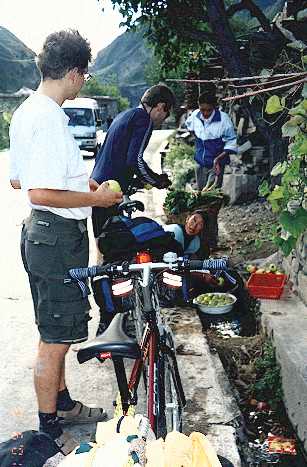 At one point we are cycling on some very
new road: the concrete is still wet and the workmen try to extort some money
for damages. We suddenly don’t understand what they are saying and
wave goodbye. The road continues uphill for 30 kilometers, but we decide
after five that we have seen enough. Both Rainer and I feel our legs burning
from the climb yesterday. However, Mark wants to go further. We tell him
we will meet him at the intersection with the main road if he doesn’t
return in five minutes. As well wait we realize that bank along the road
is hanging on by a toenail, and we moving cautiously to the other side.
Mark soon returns and we head back to the main road. As we pass the construction
area, the workmen have forgotten their claim against us.
At one point we are cycling on some very
new road: the concrete is still wet and the workmen try to extort some money
for damages. We suddenly don’t understand what they are saying and
wave goodbye. The road continues uphill for 30 kilometers, but we decide
after five that we have seen enough. Both Rainer and I feel our legs burning
from the climb yesterday. However, Mark wants to go further. We tell him
we will meet him at the intersection with the main road if he doesn’t
return in five minutes. As well wait we realize that bank along the road
is hanging on by a toenail, and we moving cautiously to the other side.
Mark soon returns and we head back to the main road. As we pass the construction
area, the workmen have forgotten their claim against us.
We continue west following the river and pass a long convoy of trucks parked headed up hill presumably waiting for the landslide to be cleared. Apple groves are all around us and the trees are so full that Mark comments that it looks like the trees were artificially laden with twice as many apples for propaganda and quota purposes. Mark stops to buy some from a woman washing them in the street. The price is 3 jiao (mao) per jin (half a kilogram), about 3 U.S. cents per pound. We get about 10 apples between us, but the woman refuses to take our money. I tell her that these apples are her livelihood and if she doesn’t the money, we won’t take the apples. She reluctantly accepts the one-yuan note and we leave with smiles and waves.
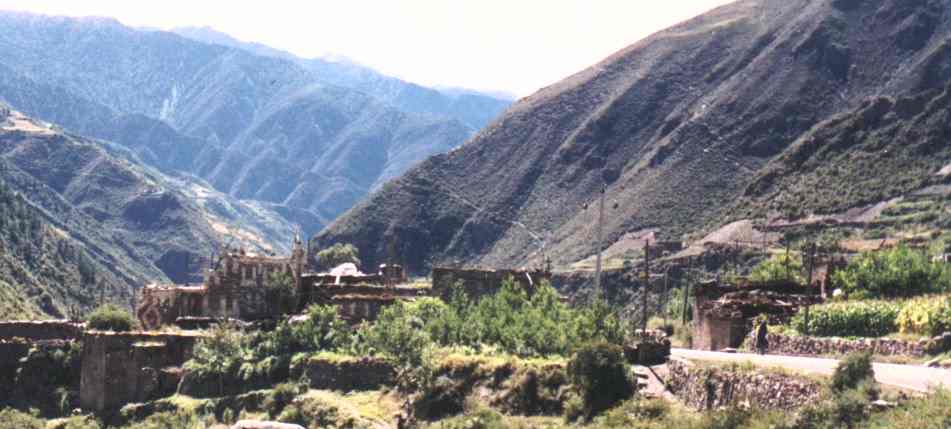
The area is becoming more and more Tibetan in appearance. Villages top mountain ridges, impossibly remote. The village buildings blend in with the rest of the landscape, made of a dusty brown rock. The people we speak with tell us the Han live on the valley floor, the Tibetans on the mountain tops. In several places we spot marijuana growing along the roadside, a reminder that there is a Muslim element here as well.
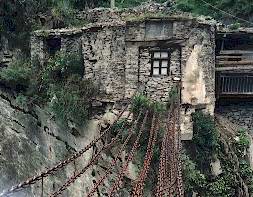 At a junction, an old hand-forged iron-chain footbridge
straddles the river beside the newer vehicle bridge. The Mark tells us it
is similar to the bridge use by Mao during the Long March before Liberation
in Luding crossing the Dadu River. This river is a tributary to it. On a
gigantic billboard nearby, Mark points out the government propaganda. In
the background is a picture of Siguniang Shan shining in the glow of a sunset,
while below are four pictures. The first three are what the Chinese government
provides to the minorities: good roads, education and cell phones, and the
fourth is what the minorities give back to the government: singing and dancing.
At a junction, an old hand-forged iron-chain footbridge
straddles the river beside the newer vehicle bridge. The Mark tells us it
is similar to the bridge use by Mao during the Long March before Liberation
in Luding crossing the Dadu River. This river is a tributary to it. On a
gigantic billboard nearby, Mark points out the government propaganda. In
the background is a picture of Siguniang Shan shining in the glow of a sunset,
while below are four pictures. The first three are what the Chinese government
provides to the minorities: good roads, education and cell phones, and the
fourth is what the minorities give back to the government: singing and dancing.
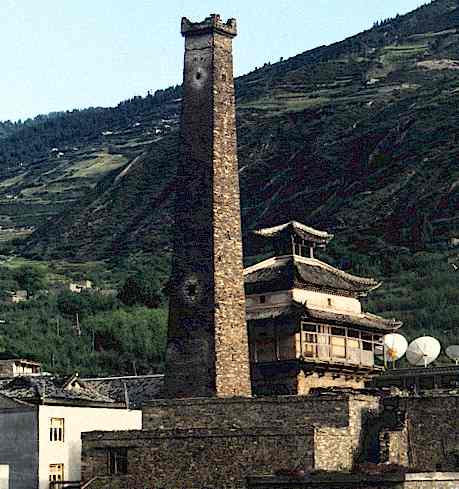
Further down the road is Wori, a Tibetan town with a unique stone watch tower and fort used by a Tibetan feudal lord to protect the town and his estate. We take a break there and do some exploring. I am struck by the cleanliness of the place. Nary a shred of paper is to be seen on the ground. People are politely curious about us and the bikes, but generally leave us alone. Mark points out the Buddhist painting that can be vaguely seen through an open door of the fort on the second floor.
Reluctantly, we push on to Xiaojin Xian, moderate-sized town at the confluence of two small rivers. Mark shows where there is a marvelous Islamic Temple, a Buddhist Temple, and a Catholic Church where Mao had spent some nights. We are tired, hungry and the light is fading, so we opt to find a place to stay and some food before exploring further. In some towns it is relatively easy to find a place at a reasonable cost, other places are more difficult. This place was the latter. We finally end up at the Government Hotel for 40 yuan each. After dinner, we go to the war monument where there is a tea house and Bar-B-Q arrangement set up around the base and join a group of moderately inebriated Tibetans, one of whom has a good command of Mandarin. Mark pumps him for information and learns that he supports the Chinese government’s efforts to improve the living conditions. He is a self-employed mini-van driver and sees the improvements as a good thing.
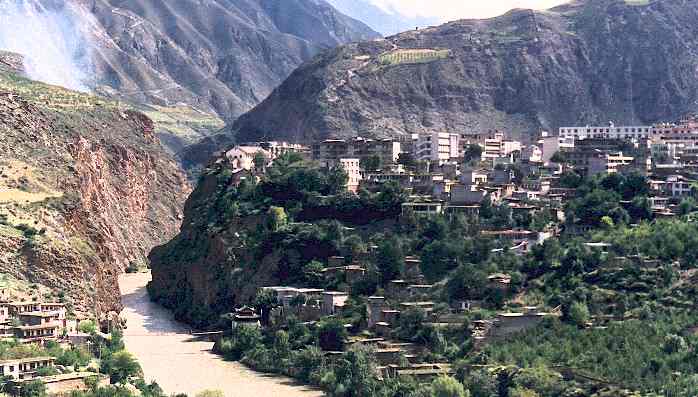
Next: Cycling Trip to Danba, Sichuan: Day 5 Xiaojin to Danba
Cycling to Danba: Part 1 | Part 2 | Part 3 | Part 4 | Part 5 | Part 6 | More Pictures
Bike China Adventures, Inc.
Home | Guided Bike Tours | Testimonials |
| Photos | Bicycle Travelogues
| Products | Info |
Contact Us
Copyright © Bike China Adventures, Inc., 1998-2012. All rights reserved.
